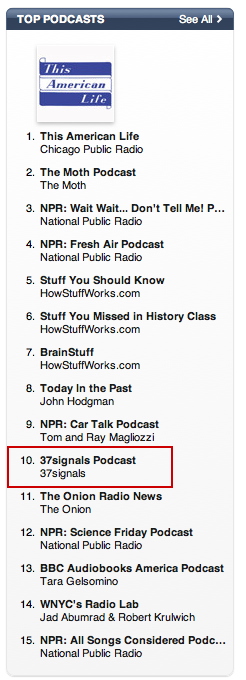
Camouflage Art by Liu Bolin: “Inspired by how some animals can blend into their environment, Liu Bolin from China uses camouflage principles to create amazing contemporary art.” Ya gotta see the rest of these too.
You’re reading Signal v. Noise, a publication about the web by Basecamp since 1999. Happy !

Now: The creator of Vooza, "the Spinal Tap of startups." Previously: Employee #1 at 37signals and co-author of the books Rework and Getting Real.

Camouflage Art by Liu Bolin: “Inspired by how some animals can blend into their environment, Liu Bolin from China uses camouflage principles to create amazing contemporary art.” Ya gotta see the rest of these too.
The About Samsonite page throws around important sounding phrases about embodying the brand, leveraging craftsmanship, and creating unique solutions.
By identifying trends and interpreting travelers’ needs, Samsonite continues to infuse innovation and new ideas into travel, re-igniting the sophistication and experience of the past.
Yawn.
It’s a good example of the way big companies wind up talking. Bloated language is what happens when copy gets filtered through a committee.
Compare that to The Saddleback Story, the tale behind bagmaker Saddleback Leather.
It all began when I had my first bag made while living in Southern Mexico as a volunteer English teacher to kids who needed a little help. I had looked everywhere for just the right bag, but with no luck…
In my search, I walked into a little leather shop and met the fellow working leather in the back. I asked him if he could make me a bag if I were to draw it out. I told him that I wanted this bag to be made so well that my grandkids would be fighting over it while I was still warm in the grave. He said “Si” and I said “Bueno” and that’s how it all started.
And it continues from there. Now that’s copy with a pulse. A personal story like that is something a little guy can deliver that a big corp can’t. A tiny company can bring people inside the fold this way and turn a perceived weakness (small size) into a strength.

Are you reading Derek Sivers’ blog? He’s really been killing it with good posts lately. The “hippie capitalist” (he’s a musician who founded CD Baby) is a master at offering simple advice that delivers real impact.
Some recent examples:
His site also offers detailed notes on books he’s read with a focus on titles about business, investing, and psychology. I’ve found those notes are a perfect match for Instapaper, the iPhone app that lets you read web pages even when you’re offline and saves your place on longer pieces. Together they make a terrific subway reading combo.
So maybe it’s time for you to join the movement. Why not carve out an hour or two a week, tell your colleagues and customers that you have cleared your schedule, that you’ll be sitting in your office, and that you hope to hear what they’re worried about, excited about, or confused about. It’s nothing fancy, nothing all that cutting edge, but it may be your most productive time of the entire week.
So we’re finalizing the layout of Rework with our publisher. We weren’t liking the appearance of the bullet lists in the book though. There were emails back and forth. Then phone calls. They thought we wanted more “flair” or a hand-drawn look to match the illustrations. We said no, we just wanted them to be “clean and consistent.”
But describing designs with words is an imperfect science. The dialogue dragged on for days. We just weren’t understanding each other.
Finally, we decided to show instead of tell. We mocked up quick and dirty versions of the lists in Pages, exported them in a PDF, and sent that over to the publisher. Took just a few minutes yet completely changed the tone of the conversation. It got everyone on the same page, we all agreed, and then we moved on.
Seems like the obvious move in retrospect. But we kept thinking that just one more email would clear up the confusion. It was a reminder of how easy it is to waste time talking around a problem when just getting real with it can get you to consensus in a fraction of the time.
The traditional advice for businesses is to “eliminate inefficiencies.” But a lot of the things that could be labelled as inefficiencies are actually what steer your product away from being a commodity. When you cut out anything that isn’t efficient, you wind up with a cookie cutter product.
Now that’s not to say you want your business to be riddled with random inefficiencies. It’s about what you purposely choose to leave in. It’s about deciding what’s important to your vision and then refusing to cut corners on those things, even if it might save you a few bucks.
“Customer Feedback Not on elBulli’s Menu” [via JK] is a Harvard Biz School look at Ferran Adrià’s restaurant El Bulli (ranked the #1 restaurant in the world). It talks about how streamlining operations at elBulli would turn it into just another restaurant.
There is much about the restaurant that is inefficient, as MBAs are quick to note: Adrià should lower his staff numbers, use cheaper ingredients, improve his supply chain, and increase the restaurant’s hours of operation. But “fixing” elBulli turns it into just another restaurant, says [HBS assistant professor Michael] Norton: “The things that make it inefficient are part of what makes it so valuable to people.”
Before you cut out something simply because it’s inefficient, ask if it’s adding value in some other way. Maybe spending extra to have pretty packaging or fresher ingredients or more durable stitching or a handwritten thank you note or whatever will wind up being why someone tells a friend about you. Often, the “wrong” things you choose to do are what set you apart and make your product unique. They’re the spice that make your dish special.
In the piece, Norton also uses Adria’s approach to highlight the distinction between understanding and listening to customers.
Adrià’s idea is that if you listen to customers, what they tell you they want will be based on something they already know. If I like a good steak, you can serve that to me, and I’ll enjoy it. But it will never be a once-in-a-lifetime experience. To create those experiences, you almost can’t listen to the customer…Adrià says he doesn’t listen to customers, yet his customers are some of the most satisfied in the world. That’s an interesting riddle to consider.
Charging for your product helps you find out who your customers are…We had all different types of people sign up for free [ScreenSteps Live] accounts including bloggers, educators and small businesses, but the only type of customer that signed up for paid accounts were those who were doing tech support. They were businesses and organizations that were in the middle of tech support nightmares. And ScreenSteps Live made the nightmare go away so they happily paid the monthly subscription fee. We instantly knew who our customers were. This guided both our marketing and development efforts.
Reader Tim Bailen writes in: “Thought you guys would like this idea — that a ‘stop doing’ list is more important than a ‘to-do’ list. It’s from Jim Collins’ study of companies that went from good to great.”
Most of us lead busy but undisciplined lives. We have ever-expanding ‘to do’ lists, trying to build momentum by doing, doing, doing—and doing more. And it rarely works. Those who built the good-to-great companies, however, made as much use of ‘stop doing’ lists as ‘to do’ lists.
Collins also discusses how “stop doing” lists can relate to one’s personal and professional life in this essay.
1) What are you deeply passionate about?
2) What are you are genetically encoded for — what activities do you feel just “made to do”?
3) What makes economic sense — what can you make a living at?Those fortunate enough to find or create a practical intersection of the three circles have the basis for a great work life.
Think of the three circles as a personal guidance mechanism. As you navigate the twists and turns of a chaotic world, it acts like a compass. Am I on target? Do I need to adjust left, up, down, right? If you make an inventory of your activities today, what percentage of your time falls outside the three circles?
If it is more than 50%, then the stop doing list might be your most important tool…
A great piece of art is composed not just of what is in the final piece, but equally important, what is not. It is the discipline to discard what does not fit — to cut out what might have already cost days or even years of effort — that distinguishes the truly exceptional artist and marks the ideal piece of work, be it a symphony, a novel, a painting, a company or, most important of all, a life.
That’s a good way to put it: You need the discipline to discard what does not fit.

The 37signals Podcast hit #10 at iTunes list of top podcasts today (and #1 in the Business category). Thanks to everyone who has subscribed! (Not subscribed yet? Sign up via iTunes or RSS.)
I have only ever designed products that I myself would like to live with so it goes without saying that we live with Braun products and Vitsoe furniture. As a designer, it is only by using your products daily that you are able to tell what sorts of improvements may still be needed.